Author: ಮನೋರಮಾ. ಬಿ.ಎನ್
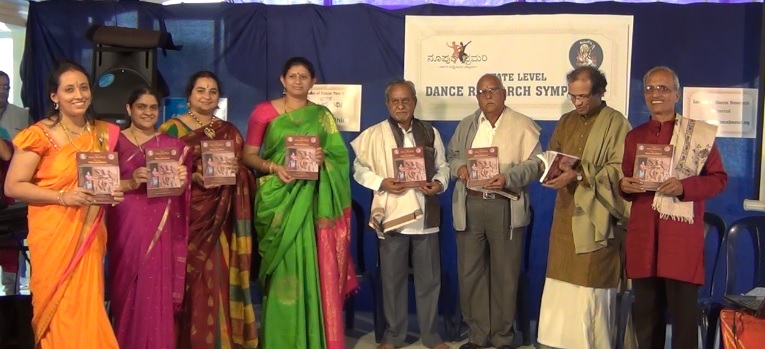
The 10th anniversary of Noopurabharamari and the first anniversary of Kalagowri was celebrated with a state level dance research symposium on Sunday 12th August, 2018 at ‘Kalagowri auditorium’, Bangalore. The theme of the symposium was the dance ability :in theory and practice. The programme started with the invocation sung by Smt. Tejaswini Dattakumar and lighting of the lamp by scholars.
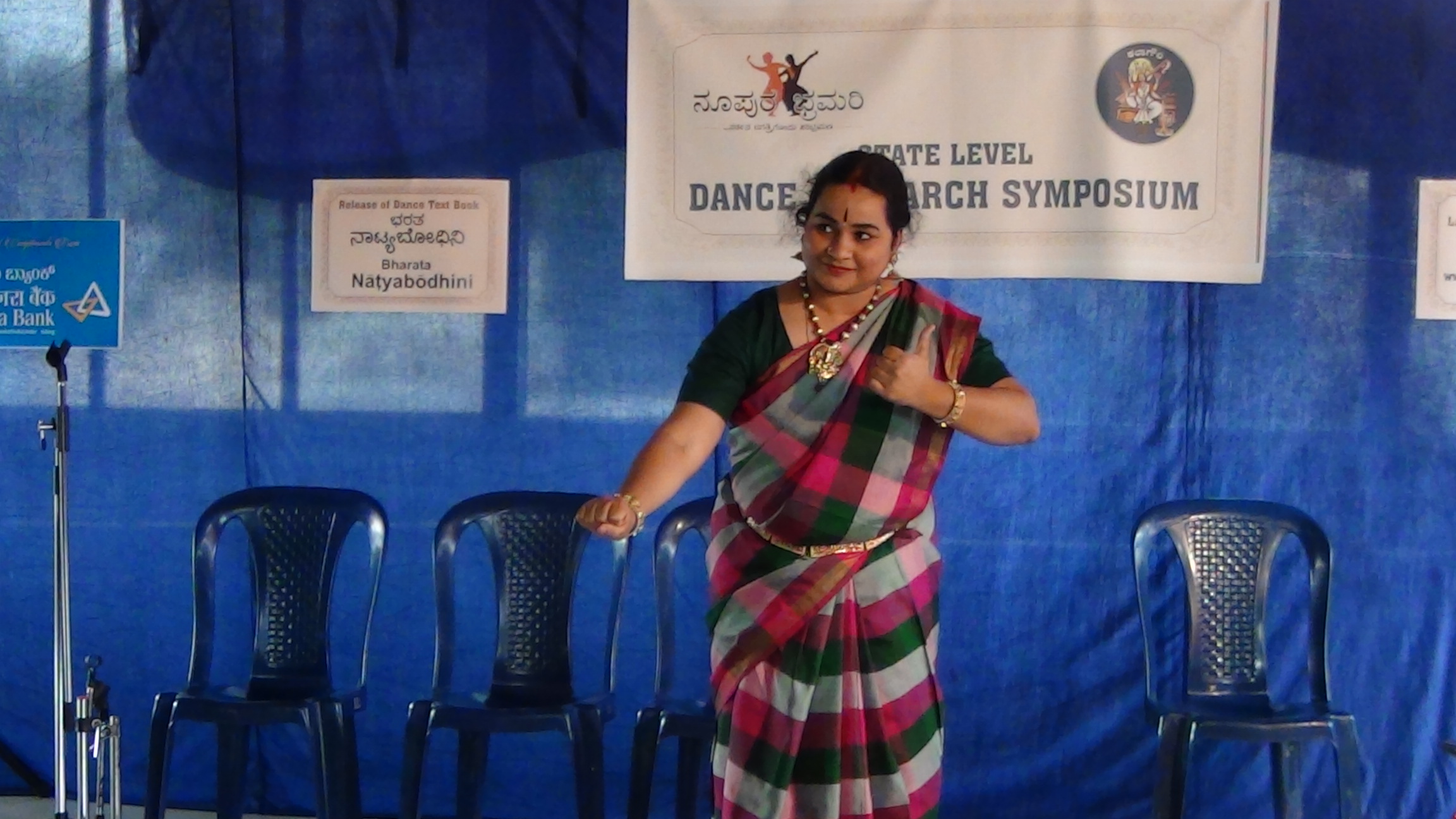
Dr Dwaritha Vishwanath’s Research paper presentation
Various research papers with practical dancing had been organised. Smt. Padmini A Rao, M. Phil, research scholar and director of ‘Sri Niketan’, from Bangalore presented a research paper ‘The Journey of the technique of Sthanaka according to Dance treatises’with practical demonstrations of Sthanakas of Kuchipudi, Kathak and Odissi. Following this, Dr. Dwaritha Viswanatha, Director: Nirmiti- An Abode of Arts and Culture and Resource person Kalai Kaviri college, presented a performance research paper on ‘Parakiya Nayika’ accompanied by Dr. Priyashri Rao on Vocal and Nattuvangam.
After this a special talk with research perspectives on ‘Universality of the tenets of Natyashastra: an analysis in terms of applicability to Shakespearean Plays’ by Arjun Bharadwaj, scholar, writer, Asst. Professor at Amrita University, was organised.
The research presentations were appreciated by both connoisseurs and scholars equally. The evening function also witnessed appreciations from the chairpersons of the symposium.
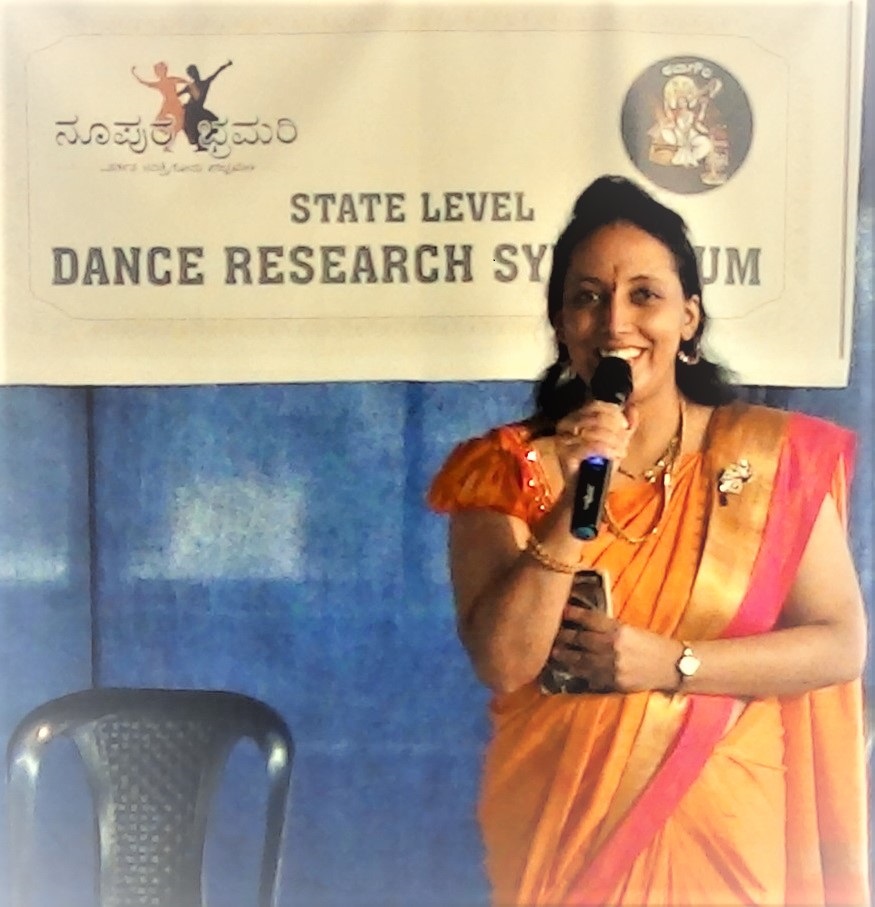
Dr Manorama B N
The evening function also witnessed the book release of the dance text book ‘Bharatanatya Bodhini’ by the world renowned Shatavadani Dr. R Ganesh, Dr. Shesha Shastri, famous researcher and scholar, Dr. H. S. Gopal Rao, Historian and ‘Vimarsha Vangmayi” Vid. Korgi Shankaranarayana Upadyaya, senior stage artist. This book has been specially designed for learners of Bharatanatyam at pre-primary, primary and post-primary levels. Being Bi- Lingual (Kannada and English), this book will be useful for Karnataka State board/ Gandharva Mandal/ Nāṭyaśāstra/ competitive/ eligibility and entrance exams. This has been published by Noopura Bhramari and Kalagowri together. Dr. Manorama has authored the research oriented original text while Shalini P. Vittal has translated it and Dr. Dwaritha Viswanatha has done emendations and transliterations. It contains 310 pages and is priced at 400Rs. Line drawings have been done by famous artists like Neernalli Ganapati Bhat, Praveen Hegde Bangi, Revathy Ragotham and Vineeth Dattakumar. Cover Page design and Pagination format has been done by Sumangala of Lavanya Printers.
After this the E- research journal of Noopura Bhramari at www.noopuradancejournal.org was launched. Following this felicitations were made to the contributors of Noopurabhramari and Bharatanatya Bodhini. S. Rama Bhat a writer from Udupi, C. S. Ramachnadra hedge, writer from Bangalore and Sumangala Srinivas kindly accepted the felicitations. S. Rama Bhat rendered a few words of appreciations.
Shatavadhani Dr. R Ganesh who spoke at the event made a reference of Noopura bhramari being the only magazine exclusive to dance in Kannada. He recollected having seen Noopura Bhramari 10 years back when it was printed in Xerox papers. He even said, that he wondered who was writing so well. He said that he has been following the growth of the magazine and is happy with its growth in respect to its content and contribution. Connecting to a person’s heart is both simple yet very complex. If the person is empathetic then it is very easy to connect and when the person is not empathetic, then even the strongest of adhesives cannot connect/ unite people. Referring to this, he said Manorama is like a river in the mansoon season, flowing with great force. She is full of energy. Sometimes small tributaries come and join her. Though sometimes a few tributaries might leave her and go. Like this she has united many artists. Manorama like the river gives pure water and makes the lives of the artists better. Mutual growth has become possible by this. Hardworking tendency is the most adorable part of her. If girls decide to achieve something, they work more than 10 men put together. Initial inertia is seen but women overcome that and achieve their dreams.
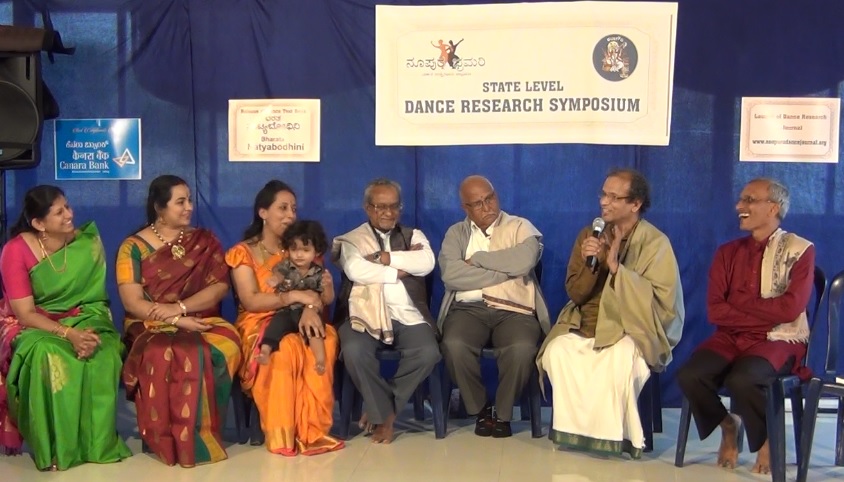 Referring to the research paer ‘Parakiya Nayika’ of Dr Dwaritha, he told ‘Every person is a parakiya nayika in this world. The ideal which are loved by them are not reachable as they have to live with reality. When put philosophically, reality is husbands and ideals are lovers. If we have to live in this world, we have to accept the reality, but live is nothing without ideals. Life is full of problems. Only people, who can be good parakiya nayikas, can be successful.’
Referring to the research paer ‘Parakiya Nayika’ of Dr Dwaritha, he told ‘Every person is a parakiya nayika in this world. The ideal which are loved by them are not reachable as they have to live with reality. When put philosophically, reality is husbands and ideals are lovers. If we have to live in this world, we have to accept the reality, but live is nothing without ideals. Life is full of problems. Only people, who can be good parakiya nayikas, can be successful.’
Dance research is fruitful only if it is practically oriented. Kalidasa says, importance should be given to practical aspects. If not, the research is futile. In chanda shastra there are few chandas which are not suitable for poetry. They only have historical importance and do have any practical value. It is the same in music also. Though it is not wrong to study about old musical pieces, research should contribute to qualitative experiments of the current trend of the music. Only then it is of value. This is what DVG calls “jagalina jignasa’(analysis in lounge) . Practical oriented research is quite rare. It is quite heartening to know that Noopura bhramari has grown towards that. By this, People who perform will be able to gain theoretical knowledge and improve their skills. In this I consider Dr. Padma Subramanian as my ideal. If Padma had researched about the Karanas without performing them practically, it would not have gained so much of importance. If, Dr. Balamurali Krishna had composed new ragas without being able to sing, it would not have gained importance. Any knowledge that cannot be applied practically remains a joke. In this way, theory and practicals must go hand in hand. This was our ancestors’ ideals and way of life. We come to know that Abhinavagupta a commentator on Natyashastra was practically proficient through his Abhinava Bharati, written before 1000 years. He used to play veena in one hand, through his other hand he put tala for his students and taught them while chewing betel leaves and drinking. It is obvious that he was immersed in happiness. It is very heartening to notice that Noopura Bhramari and Manorama are moving towards fulfilling these ideals. He felt that Manorama’s ‘Mudraarnava’, a research work based on Hastas and Mudras, is a valuable work in Kannada. Other than the basic work of the Late. Vidyalankara S. K. Ramachandra no one has researched on hastas and mudras in kannada. Manorama fulfilled the lacuna 10 years back. Keertishesha Korgi Venkateshwara Upadyaya wrote the forward for it. Now, her 6th book Bharata Natya Bodhini, has been launched Bi Lingual in Kannada and English. In this work, Small Cultural details which are seemingly not useful for dance can be seen enhancing the dance. In this work both minute and profound details are written. For example: students of dance must wear flowers and bindi. Such minute details which are a part of our culture have been noted in this book. This kind of detailing is not found in any text book these days. These days many things are taken for granted. These minute things form the culture and Art is the most cherished form of culture. Life is beautified by culture. It is good to see music and dance grow as a part of culture.
In research, it is very important to study the shastras. We should not go against the shastras without reading them. It must be well read and then contributed to. If the texts are followed blindly, it feels suppressive and binding and will lead to failure in both life and arts. There is no growth, if the texts are followed blindly. It is dangerous to think that the texts are perfect. If done so, the content which is not present will be imagined and taken as different interpretations. Intelligence, experience and theoretical knowledge when combined should lead a person to understand and fill the lacuna in the text. Expanding the knowledge without destroying the old ones is ideal. Everyone grows because of their hard work. The knowledgeable ones pick up inspiration from the mundane activity. Good results are perceivable. When in conversation with likeminded ones, new ideas flash unknowingly. It is a skill to grasp and grown from these ideas. It is good to have such symposiums and informal conversations for the growth.
From the art’s point of view, Banglore is moving in the right direction. It known that earlier, Music and dance treatises have originated in Karanataka. May the same contribution happen again. May people from other states also come and join hands for dance research.
According to me, it is not possible to receive happiness without giving happiness. No external force can inspire like self satisfaction. None of the universities or academies give patronage to arts these days. Self motivation is important for survival. We have to do our activities for our self satisfaction and any external praise should e considered as a bonus. Like how DVG says, Appreciation when received unexpectedly is like a cool breeze. But if a person works for getting appreciated by others, then it is equal to the air that comes from the hand fan. Our lives are like this currently.
The grants given by various institutions are cut because of lack of funds in the government. In this view, we have to create our own happiness from whatever is possible. In this line, the service of Kalagowri is appreciable. Without leaving its identity and without adding pride Noopura Bhramari is coordinating with Kalagowri. My appreciations to both these.
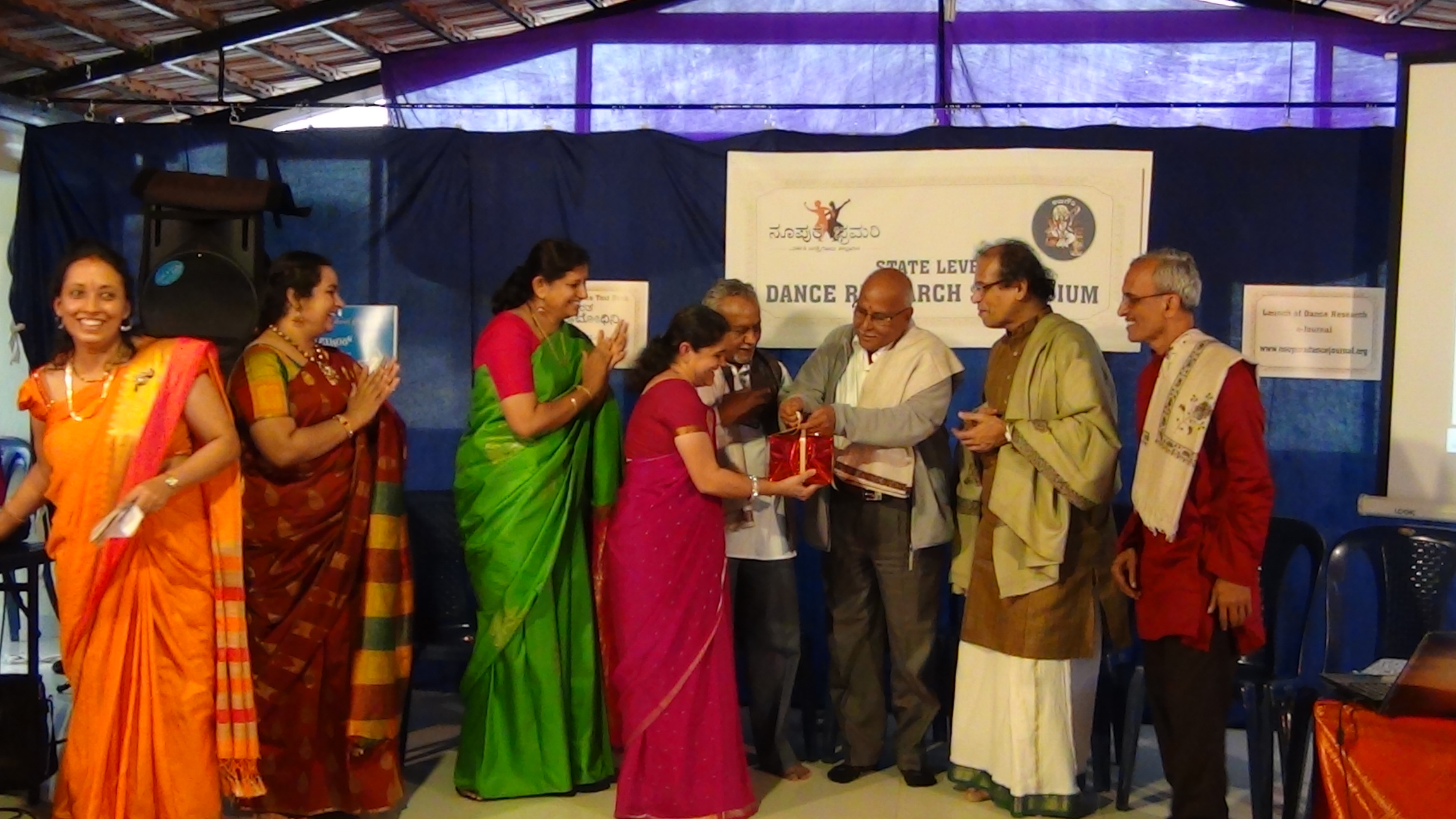
Dr. Shesha shastri, renowned scholar ad researcher spoke next in the program. He recollected his study of the Veeragallus (heroic stones on departed souls of War). When a soldier who has died in the war was taken to the heavens, apasaras are said to have danced. I realized that the costumes and postures could be researched on. When I had gone to Andhra, I met Dr. Natraj Ramakrishna. After reading his articles and research papers, I wondered why we should not study about people who follow ancient culture and traditions. When I was teaching Lasya Ranjini to him, I noticed the dance postures of U.S. Krishna Rao and Chandrabhaga Devi. After this Nataraja Ramakrishna wrote many articles and also created the Andra Natyam. When I was wondering why many haven’t followed his footsteps, Noopura Bhramari inspired me to write. Noopura Bhramari helped me in the kannada translation of Jayappa Senani’s Nritta Ratnavali . When Nritya and sahitya are studied together, such works come into being.
Historian Dr. H.S. Gopal Rao who was present, shared his research insights. Creating an institution is easy but maintain and growing it is difficult. He with his likeminded friends, built the Karnataka itihasa academy without any grants from the government. Now the academy has completed 33 years of being. The works of both Noopura Bharamari and Kalagowri are praise worthy. It simplifies and creates resources for future study.
During this celebration, Kalagowri’s founder, Shalini was honoured by her family members. Dr. K. Vasanthalakshmi, B. Bhanumati, Sai Venkatesh (president of Karnataka Nrityakala Parishad), H. S. Venugopla (renowned flutist), many research students and art lovers were present in the symposium. Compeering was done by Researcher Dr. Manorama B.N, Director Noopura Bhramari.
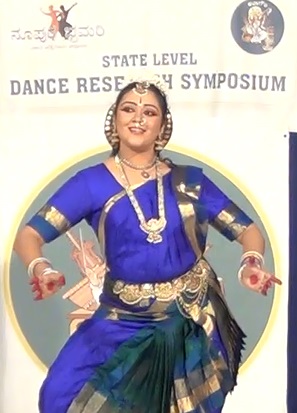
After this, ‘Kalagowri sandhya’, a dance program was conducted. In this a stuti on Kalagowri was presented by Madhulika Srivatsa. Based on Manorama B. N’s research work is Shalini Vittal has conceptualised the Kalagowri. Korgi Shnakaranarayana Upadyaya composed a stuti on Kalagowri which was choreographed by Dr. Shobha Shashikumar. It was presented in Bharatanritya style adopting Karana and Charis with new interpretations.
The next piece presented by Madhulika Srivatsa was a Kannada varnam ‘Vamshi Vilasa’ based on the Kannada translation of Leela Shuka’s Krishna Karanamrutha. This was composed by Korgi Shankaranarayana and Dr. Manorama B. N. and set to music by Kanchana Shruti Ranjini under the directions of Kanchana Rohini Subbaratnam. This Pada Varnam was based on Madhulika’s research work’ role of the nayaka in nayika compositions’.
After this Dr. Shobha Shashikumar, dance exponent and researcher, presented a bharatanritya performance. She started her performance with Korgi Shankaranarayana upadyaya’s composition based on Krishna’s childhood plays. Following this her next piece was a composition of Dr. R. Ganesh on Svadhinapatika Nayika. She concluded her performance with Annamacharya’s Brahmamokkate. Her presentation moved the rasikas to tears.
Shobha Shashikumar was conferred the title ‘Natya Bharati” on this auspicious occasion.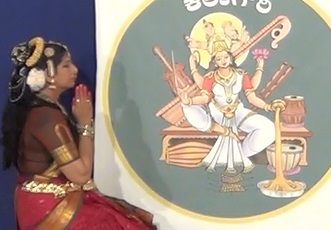
The music ensemble consisted of Nagashree Narayanan on the vocals, Megha srinivas on Nattuvangam, Vid. Giridhar on mridangam and Pramukh on the flute. The compeering was done by Korgi Shankaranarayana Upadyaya and the vote of thanks was rendered by Dr. Manorama B. N. On this occasion, an exhibition and sale of dance related books and magazines was held.
ಕನ್ನಡ ವರದಿ
ವರದಿ
ರಾಜ್ಯಮಟ್ಟದ ನೃತ್ಯಸಂಶೋಧನಾ ವಿಚಾರಸಂಕಿರಣ
ಮತ್ತು
ಭರತನಾಟ್ಯಬೋಧಿನಿ- ನೃತ್ಯ ಪಠ್ಯಕೃತಿ ಹಾಗೂ ಆನ್ಲೈನ್ ಜರ್ನಲ್ ಪೋರ್ಟಲ್ www.noopuradancejournal.org ಅನಾವರಣ
ವರದಿ : ವಿಷ್ಣುಪ್ರಸಾದ್ ಎನ್.
ನೂಪುರಭ್ರಮರಿಯು ತನ್ನ ದಶಮಾನೋತ್ಸವ ಮತ್ತು ‘ಕಲಾಗೌರಿ’ ಸಂಶ್ಥೆಯು ತನ್ನ ವಾರ್ಷಿಕೋತ್ಸವ ಪೂರ್ಣತೆಯ ಸಂಭ್ರಮದಲ್ಲಿ ರಾಜ್ಯಮಟ್ಟದ ನೃತ್ಯಸಂಶೋಧನಾ ವಿಚಾರಸಂಕಿರಣವನ್ನು ಬೆಂಗಳೂರಿನ ಕಲಾಗೌರೀ ಸಭಾಂಗಣದಲ್ಲಿ ಇತ್ತೀಚೆಗೆ (ಭಾನುವಾರ) ಹಮ್ಮಿಕೊಂಡಿತ್ತು. ವಿಚಾರಸಂಕಿರಣ ಶೀರ್ಷಿಕೆ ಶಾಸ್ತ್ರಾನ್ವಯದ ಪ್ರಯೋಗದೃಷ್ಟಿಯತ್ತ ನೃತ್ಯಚಿಂತನ ಎಂಬುದಾಗಿತ್ತು.
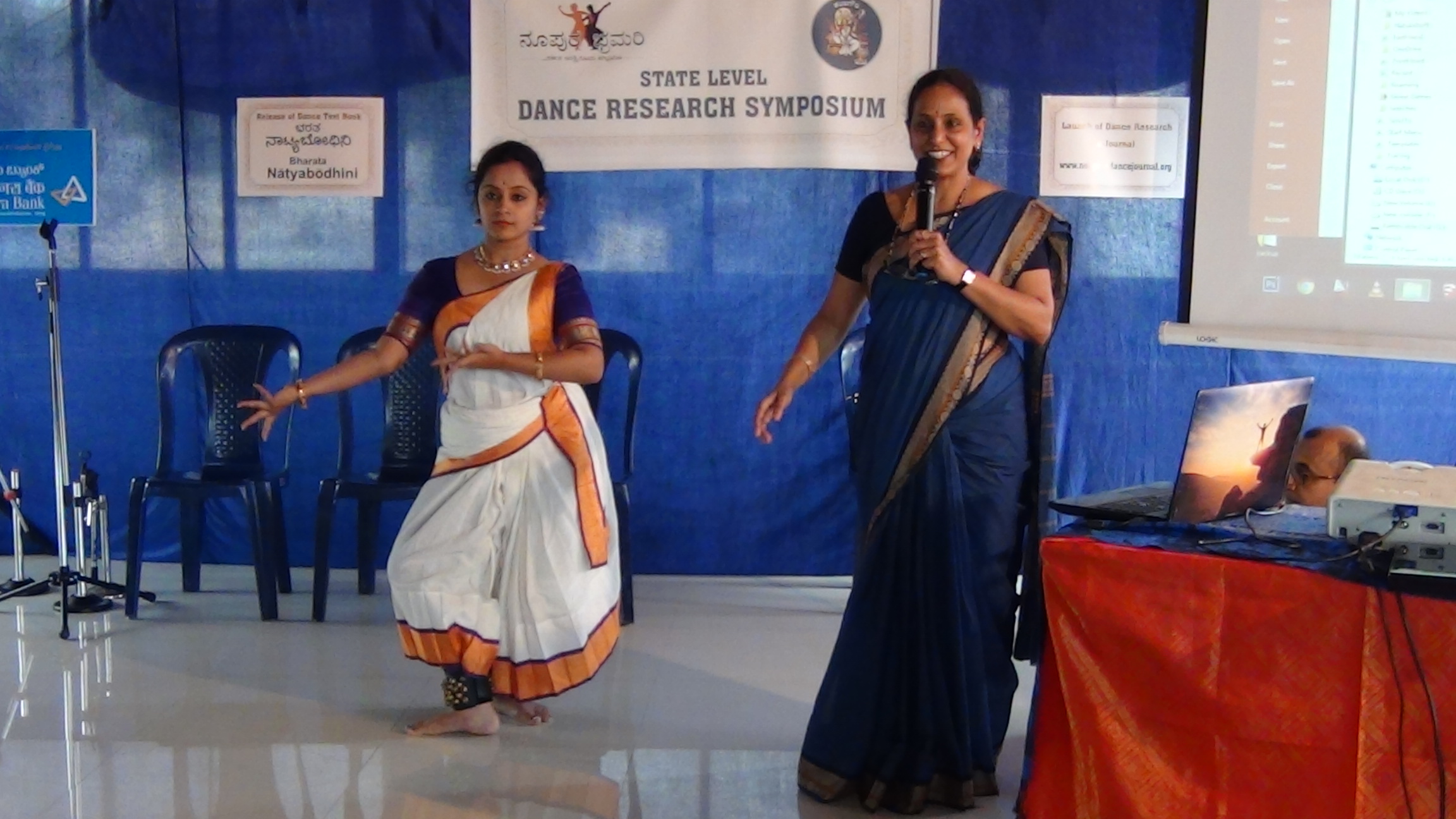
Padmini Rao A reseaprch paper presentation
ತೇಜಸ್ವಿನೀ ದತ್ತಕುಮಾರ್ ಮತ್ತು ದೀಪಪ್ರಜ್ವಲನದ ಮೂಲಕ ಆರಂಭಗೊಂಡ ಕಾರ್ಯಕ್ರಮದಲ್ಲಿ ವಿವಿಧ ಸಂಶೋಧನ ಪ್ರಬಂಧಗಳ ಮಂಡನೆ ನೃತ್ಯಸಹಿತವಾಗಿ ಏರ್ಪಡಿಸಲಾಗಿತ್ತು. ಶ್ರೀಮತಿ ಪದ್ಮಿನಿ ಎ ರಾವ್, ಸಂಶೋಧನಾಸಕ್ತರು ಮತ್ತು ನಿರ್ದೇಶಕರು ‘ ಶ್ರೀನೃತ್ಯನಿಕೇತನ’, ಇವರಿಂದ- ಲಕ್ಷಣ ಗ್ರಂಥಗಳಲ್ಲಿ ನೃತ್ಯಸ್ಥಾನಕಗಳ ತಂತ್ರಗಳ ಕುರಿತು ಕಥಕ್, ಕೂಚಿಪೂಡಿ, ಓಡಿಸ್ಸಿ ನೃತ್ಯದ ಸ್ಥಾನಕಗಳ ಪ್ರಾತ್ಯಕ್ಷಿಕೆ ಸಹಿತವಾಗಿ ನೆರವೇರಿಸಿದರು. ಡಾ. ದ್ವರಿತಾ ವಿಶ್ವನಾಥ, ನಿರ್ದೇಶಕರು – ನಿರ್ಮಿತಿ ಕಲಾಲಯ ಮತ್ತು ಉಪನ್ಯಾಸಕರು, ಕಲೈಕಾವೀರಿ ಕಾಲೇಜು ಇವರಿಂದ- ಪರಕೀಯ ನಾಯಿಕೆಯ ಕುರಿತು ನೃತ್ಯಬಂಧ ಪ್ರಾತ್ಯಕ್ಷಿಕೆಗಳ ಸಹಿತ (ಡಾ. ಪ್ರಿಯಾಶ್ರೀ ರಾವ್ ಗಾಯನ ಸಹಕಾರದೊಂದಿಗೆ) ಏರ್ಪಡಿಸಲಾಗಿತ್ತು.
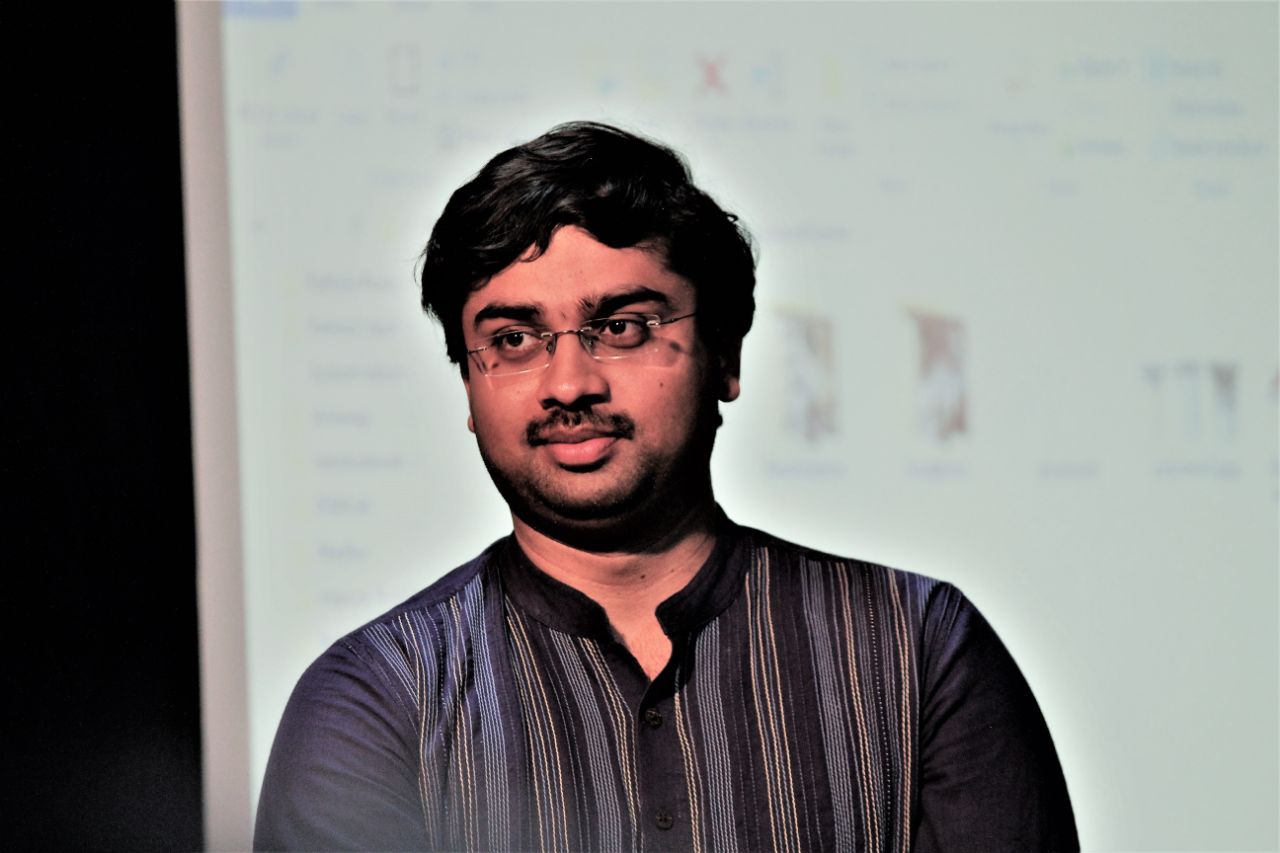
Arjun Bharadhwaj
ಇದಾದ ಬಳಿಕ ವಿಶೇಷ ಸೋದಾಹರಣ ಉಪನ್ಯಾಸ- ಶ್ರೀ ಅರ್ಜುನ್ ಭಾರಧ್ವಾಜ್, ವಿದ್ವಾಂಸರು ಮತ್ತು ಸಹಾಯಕ ಪ್ರಾಧ್ಯಾಪಕರು, ಅಮೃತ ವಿಶ್ವವಿದ್ಯಾನಿಲಯ ಇವರಿಂದ- ನಾಟ್ಯಶಾಸ್ತ್ರದ ಸಾರ್ವಕಾಲೀನತೆ- ಷೇಕ್ಸ್ಪಿಯರ್ ನಾಟಕಗಳಲ್ಲಿ ಅನ್ವಯದ ಕುರಿತು ಮಾತನಾಡಿದರು. ಎಲ್ಲರ ಪ್ರಬಂಧಮಂಡನಗಳೂ ವಿದ್ವಾಂಸರು ಮತ್ತು ಸಹೃದಯರಿಬ್ಬರಿಂದಲೂ ಅಪಾರವಾದ ಮೆಚ್ಚುಗೆಗೆ ಪಾತ್ರವಾದವು.
ಸಂಜೆ ನಡೆದ ಸಮಾರೋಪದಲ್ಲಿ ವಿಚಾರಸಂಕಿರಣದ ಅಧ್ಯಕ್ಷ ವಿದ್ವಾಂಸರಿಂದ ಪ್ರತಿಕ್ರಿಯೆ ಗಳು ಜರುಗಿದವು. ಇದೇ ಸಂದರ್ಭದಲ್ಲಿ ಭರತನಾಟ್ಯಬೋಧಿನಿ- ನೃತ್ಯ ಪಠ್ಯಕೃತಿಯನ್ನು ನಾಡಿನ ಹೆಸರಾಂತ ಬಹುಶ್ರುತ ವಿದ್ವಾಂಸರಾದ ಶತಾವಧಾನಿ ಡಾ. ಆರ್. ಗಣೇಶ್, ಹೆಸರಾಂತ ಸಂಶೋಧಕರೂ, ವಿದ್ವಾಂಸರೂ ಆಗಿರುವ ಡಾ. ಶೇಷ ಶಾಸ್ತ್ರಿ, ಇತಿಹಾಸ ತಜ್ಞ ಡಾ. ಎಚ್.ಎಸ್. ಗೋಪಾಲರಾವ್ ಮತ್ತು ‘ವಿಮರ್ಶಾ ವಾಙ್ಮಯಿ’, ಹಿರಿಯ ರಂಗಕರ್ಮಿ ವಿದ್ವಾನ್ ಕೊರ್ಗಿ ಶಂಕರನಾರಾಯಣ ಉಪಾಧ್ಯಾಯ ಅವರಿಂದ ಅನಾವರಣ ಗೊಂಡಿತು. ಈ ಕೃತಿಯು ಭರತನಾಟ್ಯವನ್ನು ಕಲಿಯುವ ಪ್ರಾಥಮಿಕ ಪೂರ್ವ/ಪ್ರಾಥಮಿಕ/ಪ್ರಾಥಮಿಕ ಅನಂತರ ಹಂತದವರಿಗಾಗಿ ರಚಿಸಲಾಗಿದ್ದು; ಕನ್ನಡ ಮತ್ತು ಇಂಗ್ಲೀಷ್ ಎರಡೂ ಭಾಷೆಗಳಲ್ಲಿ ಏಕಕಾಲಕ್ಕೆ ಪ್ರಕಟಗೊಂಡು ಕರ್ನಾಟಕದ ನೃತ್ಯಪರೀಕ್ಷೆ/ಗಂಧರ್ವ/ನಾಟ್ಯಶಾಸ್ತ್ರ/ಸ್ಪರ್ಧಾತ್ಮಕ/ಅರ್ಹತಾ ಪರೀಕ್ಷೆಗಳಿಗೂ ಉಪಯುಕ್ತವಾದುದಾಗಿದೆ. ನೂಪುರ ಭ್ರಮರಿ (ರಿ.)ಮತ್ತು ಕಲಾಗೌರಿ ಸಂಸ್ಥೆಗಳಿಂದ ಪ್ರಕಾಶನ ಮಾಡಲಾಗಿದ್ದು ಡಾ. ಮನೋರಮಾ ಅಧ್ಯಯನನಿಷ್ಠವಾಗಿ ಮೂಲ ಕನ್ನಡ ಪಠ್ಯವನ್ನು ರಚಿಸಿದರೆ; ಇಂಗ್ಲೀಷ್ಗೆ ಭಾಷಾನುವಾದವನ್ನು ಶಾಲಿನಿ ಪಿ. ವಿಠಲ್ ಮತ್ತು ಡಾ.ದ್ವರಿತಾ ವಿಶ್ವನಾಥ ಮಾಡಿದ್ದಾರೆ. ಸುಮಾರು ೩೧೦ ಪುಟಗಳ ಈ ಕೃತಿ ೪೦೦ ರೂ ಮುಖಬೆಲೆಯುಳ್ಳದ್ದಾಗಿದೆ. ರೇಖಾಚಿತ್ರಗಳನ್ನು ನಾಡಿನ ಖ್ಯಾತ ಕಲಾವಿದರಾದ ನೀರ್ನಳ್ಳೀ ಗಣಪತಿ ಭಟ್, ಪ್ರವೀಣ್ ಹೆಗಡೆ ಬಣಗಿ, ರೇವತಿ ರಘೋತ್ತಮ್ ಮತ್ತು ವಿನೀತ್ ದತ್ತಕುಮಾರ್ ಅವರು ರಚಿಸಿದ್ದಾರೆ. ಮುಖಪುಟ ಮತ್ತು ಪುಟವಿನ್ಯಾಸವನ್ನು ಲಾವಣ್ಯ ಮುದ್ರಣದ ಸುಮಂಗಲಾ ಅವರು ಮಾಡಿದ್ದಾರೆ.
ಇದಾದ ಬಳಿಕ ನೃತ್ಯಸಂಶೋಧನೆಗೆಂದೇ ಮೀಸಲಾದ ನೂಪುರ ಭ್ರಮರಿಯ ಆನ್ಲೈನ್ ಜರ್ನಲ್ ಪೋರ್ಟಲ್ www.noopuradancejournal.org ಅನಾವರಣಗೊಂಡಿತು. ನೂಪುರ ಭ್ರಮರಿಗೆ ಮತ್ತು ಭರತನಾಟ್ಯಬೋಧಿನಿ ಪುಸ್ತಕಕ್ಕಾಗಿ ದುಡಿದ ಸಾಧಕರಿಗೆ ಸನ್ಮಾನ ಕಾರ್ಯಕ್ರಮವೂ ಸಂಪನ್ನವಾಯಿತು. ಉಡುಪಿಯ ಬರೆಹಗಾರ ಎನ್.ರಾಮ ಭಟ್, ಬೆಂಗಳೂರಿನ ಬರೆಹಗಾರ ಸಿ.ಎಸ್.ರಾಮಚಂದ್ರ ಹೆಗಡೆ ಮತ್ತು ಸುಮಂಗಲಾ ಶ್ರೀನಿವಾಸ್ ಅವರು ಸನ್ಮಾನ ಸ್ವೀಕರಿಸಿದರು. ಸನ್ಮಾನಿತರ ಪರವಾಗಿ ಎನ್ ರಾಮ ಭಟ್ ತಮ್ಮ ಅಭಿಪ್ರಾಯವನ್ನು ಹಂಚಿಕೊಂಡರು. ಪುಸ್ತಕದ ಪ್ರಥಮ ಗೌರವಪ್ರತಿಗಳನ್ನು ನೃತ್ಯವಿದುಷಿ ಡಾ. ಕೆ. ವಸಂತಲಕ್ಷ್ಮಿ, ಡಾ.ಪ್ರಿಯಾಶ್ರೀ ರಾವ್ ಮತ್ತು ವಿದ್ವಾನ್ ಎಚ್.ಎಸ್.ವೇಣುಗೋಪಾಲ್ ಅವರಿಗೆ ಪ್ರದಾನ ಮಾಡಲಾಯಿತು.
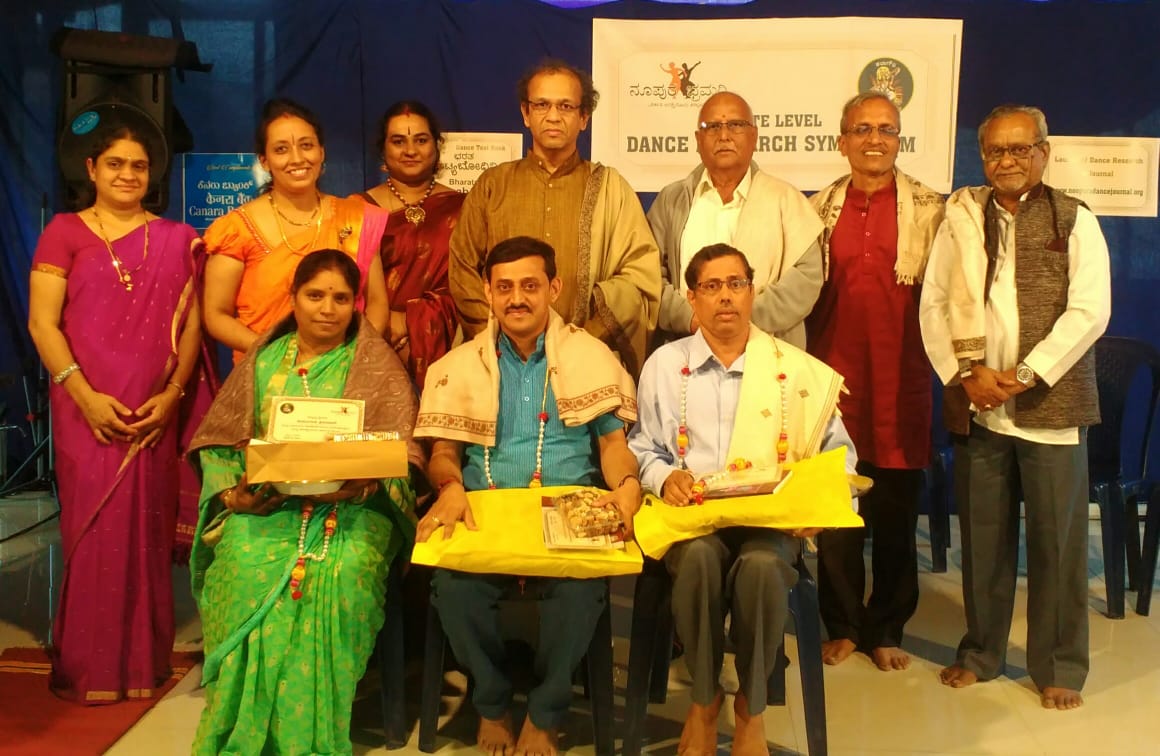
Feliciation to sumangala, Ramachandra hegde and Rama bhat
ಈ ಸಂದರ್ಭದಲ್ಲಿ ಮಾತನಾಡಿದ ಶತಾವಧಾನಿ.ಡಾ. ಆರ್. ಗಣೇಶ್ ಅವರು ಕನ್ನಡದಲ್ಲಿ ನೃತ್ಯಕ್ಕೆಂದೇ ಮೀಸಲಾದ ಪತ್ರಿಕೆ ಮತ್ತೊಂದಿಲ್ಲ. ಹತ್ತುವರ್ಷಗಳ ಕೆಳಗೆ ನೂಪುರ ಭ್ರಮರಿ ಜೆರಾಕ್ಸ್ ಪೇಪರ್ಗಳಲ್ಲಿ ಶುರುವಾದಾಗಿನಿಂದಲೂ ನೋಡಿ ಬಲ್ಲೆ. ಆಗೆಲ್ಲಾ ಇಷ್ಟೊಂದು ಪ್ರೌಢವಾಗಿ, ಚೆನ್ನಾಗಿ ಮೊದಮೊದಲ ದಿನಗಳಲ್ಲಿಯೇ ಬರುತ್ತಿದೆಯಲ್ಲಾ ಎಂದೆನಿಸಿತ್ತು. ಇದನ್ನು ಸಮರ್ಥವಾಗಿ ವರ್ಷದಿಂದ ವರ್ಷಕ್ಕೆ ಗುಣಮಟ್ಟದಲ್ಲಿ ಪರಿಚಯ ವಿಸ್ತಾರವನ್ನು ಮಾಡುತ್ತಾ ಅವರು ಬಂದಿದ್ದುಗಮನಿಸಿದಾಗ ತುಂಬಾ ಸಂತೋಷವಾಗುತ್ತದೆ. ಮನುಷ್ಯರನ್ನು ಮಸುಗಳನ್ನು ಬೆಸೆಯುವುದು ಒಂದರ್ಥದಲ್ಲಿ ಸುಲಭ ಮತ್ತು ಕಷ್ಟ ಎರಡೂ ಹೌದು. ಸಂವೇದನಾಶೀಲರಾಗದೇ ಹೋದರೆ ಯಾವ ಭದ್ರಲೇಪಗಳನ್ನು ಮಾಡಿದರೂ ಅದು ಸಾಧ್ಯವಾಗುವುದಿಲ್ಲ. ಹಾಗೆ ನೋಡಿದರೆ ಮಳೆಗಾಲದ ಘಟ್ಟದ ನೀರಿನಂತೆ ಮನೋರಮಾ ಅವರ ಕರ್ತವ್ಯ. ಸದಾ ಭೋರ್ಗರೆದು ಹರಿಯುವುದು ಅವರ ಸ್ವಭಾವ. ಅದಕ್ಕೆ ಕೆಲವೊಮ್ಮೆ ಉಪನದಿಗಳು ಬಂದು ಸೇರಿಕೊಳ್ಳುತ್ತವೆ, ಕೆಲವೊಂದು ಅದಾಗಿಯೇ ಬಿಟ್ಟುಹೋಗಲೂಬಹುದು. ಹಾಗೆ ಹಲವಾರು ಕಲಾವಿದರನ್ನು ಒಟ್ಟುಗೂಡಿಸಿಕೊಂಡು ಬಂದಿದ್ದಾರೆ. ಹೀಗೆ ನದಿಯಾಗಿ ಹರಿಯುತ್ತಾ ಒಳ್ಳೆಯ ನೀರನ್ನೇ ಕೊಡುತ್ತಾ ಬಾಳುವ ಮತ್ತು ಬಾಳಿಸುವ ಕೆಲಸವನ್ನು ಮಾಡುತ್ತಿದ್ದಾರೆ. ಪರಸ್ಪರ ಪೋಷಣೆ ಇದರಿಂದ ಸಾಧ್ಯವಾಗಿದೆ. ಎಲ್ಲದಕ್ಕಿಂತ ದೊಡ್ಡದೆಂದರೆ ದುಡಿವ ಮನಸ್ಸು. ಹೆಣ್ಣುಮಕ್ಕಳಿಗೆ ಏನಾದರೂ ಸಾಧಿಸಬೇಕೆಂಬ ಹಟ, ಛಲ ಮನಸ್ಸಿಗೆ ಬಂದರೆ ಹತ್ತು ಜನ ಗಂಡಸರಿಗಿಂತ ಚೆನ್ನಾಗಿ ದುಡಿಯುತ್ತಾರೆ. ಆರಂಭಿಕವಾಗಿ ಹಿನ್ನೆಡೆಗಳು, ತಾಪತ್ರಯಗಳು ಕಾಣುವುದು ಸಹಜ. ಆದರೆ ಅದೆಲ್ಲವನ್ನೂ ಸಾವರಿಸಿಕೊಂಡು ಮುನ್ನಡೆವ ಶಕ್ತಿ ಇರುವುದು ಹೆಣ್ಣುಮಕ್ಕಳಿಗೇ ಎಂದರು.
ಜಗತ್ತಿನಲ್ಲಿ ಎಲ್ಲಾ ಮನುಷ್ಯರೂ ಪರಕೀಯ ನಾಯಿಕೆಯರೇ. ತಾವು ಪ್ರೀತಿಸುವ ಆದರ್ಶದ ಚಿತ್ರಣ ಕೈಗೆಟುಕದು.ಆದರೆ ನಿತ್ಯವೂ ಬದುಕುವುದು ಲೋಕವಾಸ್ತವದೊಂದಿಗೆ. ಅದರಲ್ಲೂ ತಾತ್ವಿಕವಾಗಿ ಹೇಳುವುದಾದರೆ ವಾಸ್ತವ ಎನ್ನುವುದು ಸಂಗಾತಿಯಾದರೆ, ಆದರ್ಶ ಎಂಬುದು ಪ್ರಿಯಕರ. ಜಗತ್ತಿನೊಂದಿಗೆ ನಮ್ಮ ಸಂಸಾರವಿರಬೇಕೆಂದರೆ ವಾಸ್ತವವನ್ನು ಹಿಡಿಯಬೇಕು. ಆದರೆ ಬದುಕು ಆದರ್ಶಗಳಿಲ್ಲದೇ ಇಲ್ಲ. ಒಟ್ಟಿನಲ್ಲಿ ಹೆಣಗಾಟದ ಜೀವನ. ಜಗತ್ತಿನಲ್ಲಿ ಒಳ್ಳೆಯ ಪರಕೀಯ ನಾಯಿಕೆಯರಾಗಲು ಯಾರಿಗೆ ಆಗುತ್ತದೆಯೋ ಅಂಥವರು ಸಾರ್ಥಕ ಜೀವನ ನಡೆಸುತ್ತಾರೆ.
ನೃತ್ಯಸಂಶೋಧನೆಗಳು ಯಾವಾಗಲೂ ಪ್ರಯೋಗಮುಖಿಯಾದರೇನೇ ಅದು ಸಾರ್ಥಕ. ಇಲ್ಲದಿದ್ದರೆ ಅದು ಕೇವಲ ಗಾಳಿಮಾತು ಆಗಿಬಿಡುತ್ತವೆ. ಕಾಳಿದಾಸನೇ ಹೇಳುವಂತೆ ಪ್ರಯೋಗಕ್ಕೆ ಪ್ರಾಶಸ್ತ್ಯ ಇರಬೇಕು. ಇಲ್ಲದಿದ್ದರೆ ಅದಕ್ಕೆ ಬೆಲೆಯಿರುವುದಿಲ್ಲ.ಈಗ ಛಂದಶಾಸ್ತ್ರದಲ್ಲಿಯೇ ತೆಗೆದುಕೊಂಡರೆ ಯಾವುದ್ಯಾವುದೋ ಪ್ರಯೋಗಕ್ಕೆ ಒಗ್ಗದ ಛಂದಸ್ಸುಗಳೆಲ್ಲಾ ಶಾಸ್ತ್ರದಲ್ಲಿ ಉಲ್ಲೇಖಿತವಾಗಿ ಐತಿಹಾಸಿಕವಾದ ಮಹತ್ತ್ವವಿದ್ದರೂ ಅವಕ್ಕೆ ಪ್ರಾಯೋಗಿಕ ಪ್ರಾಶಸ್ತ್ಯವಿಲ್ಲ. ಸಂಗೀತದಲ್ಲಾದರೂ ಹೀಗೆ. ಹಳೆಯ ಯಾವುದೋ ಸಂಗೀತಕ್ರಮದ ಬಗ್ಗೆ ಅಧ್ಯಯನ ಮಾಡುವುದು ತಪ್ಪಲ್ಲವಾದರೂ ಈ ಹೊತ್ತಿನ ಸಂಗೀತಕ್ಕೆ ಅದರ ಗುಣಮಟ್ಟದ ಪ್ರಯೋಗಕ್ಕೆ ಕೊಡುಗೆ ನೀಡುವಂತಹ ಸಂಶೋಧನೆಗಳು ಮೂಡಿಬಂದರೇನೇ ಅದಕ್ಕೊಂದು ಪ್ರಾಯೋಗಿಕ ಮೌಲ್ಯ ಸಿದ್ಧಿಸುತ್ತದೆ. ಇದನ್ನೇ ಡಿವಿಜಿಯವರು ಜಗಲಿಯ ಜಿಜ್ಞಾಸೆ ಎನ್ನುತ್ತಾರೆ. ಇದು ಬಹಳ ಅಪರೂಪವಾದಂತದ್ದೂ ಕೂಡಾ. ಆ ಕಡೆಗೆ ನೂಪುರ ಭ್ರಮರಿ ತನ್ನ ಮುಖ ಮಾಡಿಯೇ ಬೆಳೆದಿರುವುದು ಸಂತೋಷದ ಸಂಗತಿ. ಇದರಿಂದ ಪ್ರಯೋಗದಲ್ಲಿ ತೊಡಗಿಕೊಂಡಿರುವವರಿಗೆ ತತ್ತ್ವದ ಅನುಕೂಲವೂ ಸಿದ್ಧಿಸಿ ಸಾಮರ್ಥ್ಯ ವೃದ್ಧಿಯಾಗುತ್ತದೆ. ಈ ನಿಟ್ಟಿನಲ್ಲಿ ನನಗೆ ದೊಡ್ಡ ಆದರ್ಶವಾಗಿ ಡಾ. ಪದ್ಮಾ ಸುಬ್ರಹ್ಮಣ್ಯಂ ಅವರು ಕಾಣಿಸುತ್ತಾರೆ. ಪದ್ಮಾ ಅವರು ಕರಣಗಳನ್ನು ಅಭಿನಯಿಸದೇ ಸಂಶೋಧನೆ ಮಾಡಿದ್ದಿದ್ದರೆ ಖಂಡಿತಾ ಅದಕ್ಕೊಂದು ಪ್ರಾಶಸ್ತ್ಯ ಬರುತ್ತಿರಲಿಲ್ಲ. ಡಾ. ಬಾಲಮುರಳೀಕೃಷ್ಣ ಅವರೂ ಹಾಡೋದಕ್ಕೆ ಬಾರದೇ ಹೊಸ ರಾಗಗಳನ್ನು ಹೇಳಿದ್ದಿದ್ದರೆ ಅದಕ್ಕೊಂದು ಮಹತ್ತ್ವ ಸಿಗುತ್ತಿರಲಿಲ್ಲ. ಶಾಸ್ತ್ರದಲ್ಲಿ ಎಷ್ಟೇ ದೊಡ್ಡ ಬದನೆಕಾಯಿ ಹೇಳಿದ್ರೂ ಆಚರಣೆಯಲ್ಲಿ ಇಲ್ಲದುದ್ದನ್ನು ಹೇಳಿದರೆ ಅದೊಂದು ವಿಡಂಬನೆಯೇ ಆಗುತ್ತದೆ. ಈ ದೃಷ್ಟಿಯಿಂದ ತತ್ತ್ವ-ಪ್ರಯೋಗಗಳು, ಲಕ್ಷ್ಯ-ಲಕ್ಷಣಗಳು ಒಟ್ಟೊಟ್ಟಿಗೆ ಹೋಗಬೇಕು. ಇದು ನಮ್ಮ ಪ್ರಾಚೀನರ ಲಕ್ಷಣವೂ ಹೌದು, ಆದರ್ಶವೂ ಹೌದು. ಸುಮಾರು ಸಾವಿರ ವರ್ಷಗಳ ಕೆಳಗೆ ಬಾಳಿ ಬದುಕಿದ್ದ, ನಾಟ್ಯಶಾಸ್ತ್ರಕ್ಕೆ ವ್ಯಾಖ್ಯಾನ ಬರೆದ ಅಭಿನವಗುಪ್ತನೂ ಹೀಗೆಯೇ ಪ್ರಾಯೋಗಿಕ ನೆಲೆಯಲ್ಲಿಯೇ ಇದ್ದನೆಂಬುದು ಆತನ ವ್ಯಾಖ್ಯಾನ ಅಭಿನವಭಾರತಿಯಿಂದ ತಿಳಿದುಬರುತ್ತದೆ. ಒಂದು ಕೈಯಲ್ಲಿ ವೀಣೆ ನುಡಿಸಿಕೊಂಡು, ಮತ್ತೊಂದೆಡೆ ಶಿಷ್ಯರಿಗೆ ತಾಳ ಹಾಕಿಕೊಂಡು ಪಾಠ ಹೇಳುತ್ತಾ, ವೀಳ್ಯದೆಲೆಯನ್ನೂ ಮೆಲ್ಲುತ್ತಾ, ಪಾನೀಯವನ್ನೂ ತನ್ಮಧ್ಯೆ ಸೇವಿಸುತ್ತಾ ಆನಂದದಲ್ಲಿದ್ದ ಎನ್ನುವುದು ತಿಳಿಯುತ್ತದೆ. ಈ ಸಮಗ್ರತೆ, ಮಹಾ ಆದರ್ಶದ ಕಡೆಗೆ ಮನೋರಮಾ ಅವರ, ನೂಪುರಭ್ರಮರಿಯ ಕಾರ್ಯಗಳು ಸಾಗಿಬರುತ್ತಿರುವುದು ಸಂತಸದ ಸಂಗತಿ.
ಮನೋರಮಾ ಅವರ ಮುದ್ರಾರ್ಣವ- ಹಸ್ತಮುದ್ರೆಗಳ ಕುರಿತ ಅವರ ಮೊದಲ ಸಂಶೋಧನ ಅಧ್ಯಯನವು ನಿಜಕ್ಕೂ ಯಾವ ಕಾಲಕ್ಕೂ ಕನ್ನಡದ ಬೆಲೆಬಾಳುವ ಕೃತಿಗಳಲ್ಲೊಂದು ಎಂಬುದು ನನ್ನ ಪ್ರಾಮಾಣಿಕ ಅಭಿಪ್ರಾಯ. ಸ್ವರ್ಗೀಯ ವಿದ್ಯಾಲಂಕಾರ ಸಾ.ಕೃ.ರಾಮಚಂದ್ರರಾಯರು ತಮ್ಮದೊಂದು ಕೃತಿಯಲ್ಲಿ ಹಸ್ತಮುದ್ರೆಗಳ ತಲಸ್ಪರ್ಶಿ ನೋಟವನ್ನು ನೀಡಿದ್ದು ಬಿಟ್ಟರೆ ಈವರೆಗೂ ಬೇರೊಂದು ಕೃತಿಯಿದ್ದಿರಲಿಲ್ಲ. ಆ ಕೊರತೆಯನ್ನು ಡಾ.ಮನೋರಮಾ ಅವರು ಹತ್ತುವರ್ಷಗಳ ಹಿಂದೆಯೇ ನೀಗಿಸಿದರು. ಕೀರ್ತಿಶೇಷ ಕೊರ್ಗಿ ವೇಂಕಟೇಶ್ವರ ಉಪಾಧ್ಯಾಯರು ಅದಕ್ಕೆ ಸಹಕಾರ, ಮುನ್ನುಡಿಯನ್ನೂ ನೀಡಿದ್ದರು.
ಈಗ ಇವರ ಆರನೇಯ ಕೃತಿ ‘ಭರತನಾಟ್ಯಬೋಧಿನಿ’- ಕನ್ನಡ ಮತ್ತು ಇಂಗ್ಲೀಷ್ಗಳಲ್ಲೆರಡಲ್ಲೂ ಸಮತೂಕದಿಂದ ಅನಾವರಣವಾಗಿದೆ. ಸಂಸ್ಕೃತಿಯ ಸಣ್ಣ ಸಣ್ಣ ವಿವರಗಳೂ ನೃತ್ಯಕ್ಕೆ ನೇರ ಪ್ರಯೋಜನವಲ್ಲ ಎಂದು ಮೇಲ್ನೋಟಕ್ಕೆ ಅಂದುಕೊಂಡರೂ ಅದು ಪರೋಕ್ಷವಾಗಿ ನೃತ್ಯವನ್ನೂ ಸಲಹುತ್ತದೆ ಎಂಬುದನ್ನು ಈ ಕೃತಿಯಲ್ಲಿ ಗಮನಿಸಬಹುದು. ಇದರಲ್ಲಿ ಸೂಕ್ಷ್ಮ, ಸ್ಥೂಲ ಎರಡೂ ಸ್ತರದಲ್ಲಿ ವಿವರಗಳು ಮೂಡಿಬಂದಿವೆ. ಉದಾಹರಣೆಗೆ ನೃತ್ಯಾಭ್ಯಾಸಿಗಳು ಹಣೆಗೆ ಕುಂಕುಮವನ್ನಿಟ್ಟುಕೊಳ್ಳಿ, ಹೂವು ಮುಡಿದುಕೊಳ್ಳಿ ಎಂಬ ಸಣ್ಣ ಸಣ್ಣ ಸಂಗತಿಗಳೂ ನೃತ್ಯವನ್ನು ಬೆಳೆಸಿದ ಸಂಸ್ಕೃತಿಗೆಂದೇ ಇರುವುದನ್ನು ನೋಡಿದರೆ ಅದರೆಡೆಗಿನ ಕೃತಜ್ಞಭಾವ ಎದ್ದು ತೋರುತ್ತದೆ. ಇಂತಹ ವಿವರಗಳು ಈ ಹೊತ್ತಿನ ಯಾವುದೇ ಪಠ್ಯಪುಸ್ತಕಗಳಲ್ಲೂ ನಾವು ಕಾಣಲು ಸಾಧ್ಯವಿಲ್ಲ. ಅಡುಗೆ ಮಾಡಬೇಕಾದರೆ ಒಲೆ ಹೊತ್ತಿಸಬೇಕು ಎನ್ನುವುದನ್ನೂ ಹೇಳಬೇಕಾಗಿದೆ. ಈ ಹೊತ್ತಿಗೆ ಎಷ್ಟೋ ‘ಟೇಕನ್ ಫಾರ್ ಘ್ರಾಂಟಡ್’ ಅಂತ ಮಾಡಿಕೊಳ್ಳುತ್ತೇವೆ. ಆದರೆ ಅವೆಲ್ಲವೂ ಸಂಸ್ಕೃತಿಯ ಅಂಗಭಾಗಗಳಾಗಿರುತ್ತವೆ. ಅದುವೇ ಸಮಗ್ರ ಬದುಕಿನ ಸ್ವಾರಸ್ಯವೂ ಆಗಿರುತ್ತದೆ. ಕಲೆಯು ಬದುಕಿನ ಒಂದು ಅಂಗಭಾಗವೇ ಆಗಿದೆ ಎನ್ನುವುದನ್ನು ಯಾವ ಕಾಲಕ್ಕೂ ಮರೆಯಬಾರದು. ಆ ಬದುಕು ಸಂಸ್ಕೃತಿಯ ಸಂಭ್ರಮದಲ್ಲಿ ಚೆನ್ನಾಗಿ ಅರಳುತ್ತದೆ. ಈ ನೆಲೆಯಲ್ಲಿ ಸಂಗೀತ-ನೃತ್ಯಗಳು ಬೆಳೆದರೆ ಒಳ್ಳೆಯ ಕೆಲಸವಾಗುತ್ತದೆ.
ಗ್ರಂಥಗಳನ್ನು ಓದಿಕೊಳ್ಳುವ ಅಧಿಕೃತತೆ ಸಂಶೋಧನೆಯಲ್ಲಿ ಬಹಳ ಮುಖ್ಯ. ಸುಮ್ಮನೆ ಶಾಸ್ತ್ರವಿರೋಧ ಮಾಡುವುದಲ್ಲ. ಶಾಸ್ತ್ರವನ್ನು ಓದಿ, ಅದರ ವಿಕಾಸ ಮಾಡಬೇಕು. ಬರಿಯ ಕುರುಡುಪಾಠ ಮಾಡಿಕೊಂಡು ಶಾಸ್ತ್ರವನ್ನು ನಿರ್ಬಂಧ ಅಂತ ಭಾವಿಸಿದರೆ ಅದು ಬದುಕಿನಲ್ಲಿ ದೊಡ್ಡ ವೈಫಲ್ಯವಾಗಿ ಕಲೆಗೂ ನಿಷ್ಪ್ರಯೋಜನವಾಗುತ್ತದೆ. ಅದೇ ಶಾಸ್ತ್ರವನ್ನು ಚಾಚೂ ತಪ್ಪದೆ ಅನುಸರಿಸಿ ಬ್ರಹ್ಮವಾಕ್ಯವೇ ಅದು ಅಂತ ಭಾವಿಸಿಕೊಂಡರೆ ಬೆಳವಣಿಗೆಯೇ ಸಾಧ್ಯವಿಲ್ಲ. ಗ್ರಂಥವು ಅಕ್ಷರಾರ್ಥದಲ್ಲಿ ಪರಿಪೂರ್ಣ ಎಂದು ಭಾವಿಸಿಕೊಂಡಾಗ ಅದು ಅಪಾಯವಾಗಿ ಅದರಲ್ಲಿ ಇಲ್ಲದ್ದನ್ನು ರಸ್ಯಾರ್ಥ, ಭೋಗ್ಯಾರ್ಥಗಳೆಂದು ತುರುಕಿ ಹಿಗ್ಗಿಸಿ ಹೇಳಬೇಕಾಗುತ್ತದೆ. ಇದರಿಂದ ಗ್ರಂಥಗಳಿಗೆ ಬೊಜ್ಜು ಬಂದುಬಿಡುತ್ತದೆ. ಯುಕ್ತಿ, ಅನುಭವ, ಶಾಸ್ತ್ರಜ್ಞಾನ ಮೇಳೈಸಿ ಗ್ರಂಥದಲ್ಲಿ ಇಲ್ಲದ್ದನ್ನೂ ಔಚಿತ್ಯಪೂರ್ಣವಾಗಿ ಅನ್ವಯಿಸಿಕೊಳ್ಳುವ ಹಾಗಾಗಬೇಕು. ಹಿರಿಯರು ಕಟ್ಟಿದ ಮನೆಯನ್ನು ಮುರಿಯದೆ ವಿಸ್ತರಿಸಿಕೊಳ್ಳುವ ಕೆಲಸ ಮಾಡುವವನೇ ನಿಜವಾದ ಮಗ ಎನ್ನುವಂತೆ ಹಳೆಯದನ್ನು ನಾಶ ಮಾಡದೆ ಅದನ್ನೇ ಬೆಳೆಸಿಕೊಳ್ಳುವುದು ಆಗಬೇಕು.
ಎಲ್ಲರೂ ಅವರವರ ಶ್ರಮದಿಂದಲೇ ಬೆಳೆಯುತ್ತಾರೆ. ನಿಜ. ಆದರೆ ಪ್ರತಿಭೆಯಿದ್ದವರು ಸುಮ್ಮನೆ ಹರಟೆ ಹೊಡೆಯುವ ಮಾತಿನಲ್ಲೂ ಸ್ಫೂರ್ತಿಯನ್ನು ಪಡೆದುಕೊಳ್ಳುತ್ತಾರೆ. ಅದರಿಂದ ಸೊಗಸಾದ ಫಲ ಬರುತ್ತದೆ. ಮಾತಿನ ಭರದಲ್ಲಿ, ಸಹೃದಯರ ಜೊತೆ ಸಂವಾದ ನಡೆಸುವಲ್ಲಿ ನಮಗೆ ಗೊತ್ತಿಲ್ಲದೆಯೇ ನಮ್ಮ ಯೋಗ್ಯತೆ, ಶಕ್ತಿಗೆ ಆವರೆಗೂ ತೋರಿಕೊಳ್ಳದೇ ಇರುವುದೂ ಕೂಡಾ ತೋರಿಕೊಂಡುಬಿಡುತ್ತದೆ. ಇದು ಪಡೆದುಕೊಳ್ಳುವವನ ಪ್ರತಿಭೆಯಲ್ಲದೆ ಬೇರೇನಲ್ಲ. ಆ ತರದಲ್ಲಿ ಈ ಬಗೆಯ ವಿಚಾರಗೋಷ್ಠಿಗಳು, ಅನೌಪಚಾರಿಕ ಸಂವಾದಗಳು ಆಗುತ್ತಾ ಬಂದರೆ ಅದು ತುಂಬಾ ಒಳ್ಳೆಯದು.
ಬೆಂಗಳೂರು ಕಲೆಯ ದೃಷ್ಟಿಯಿಂದ ಒಳ್ಳೆಯ ದಿಕ್ಕಿನಲ್ಲಿ ಬೆಳೆಯುತ್ತಿದೆ. ಹಿಂದೆಲ್ಲಾ ಸಂಗೀತ ಮತ್ತು ನೃತ್ಯದ ಅನೇಕ ಶಾಸ್ತ್ರಗ್ರಂಥಗಳು ಕರ್ನಾಟಕದಿಂದಲೇ ಬೆಳೆದುಬಂದಿರುವುದನ್ನು ನೊಡಿದ್ದೇವೆ. ಈಗ ಮತ್ತೆ ಆ ರೀತಿಯಾದ ಒಳ್ಳೆಯ ಕಾಲ ಬರಲಿ. ಬೇರೆ ಪ್ರಾಂತಗಳಿಂದ ಬಂದವರೂ ಸಂತೋಷದಿಂದ ಸೇರಿ ಸಂಶೋಧನೆ ಮತ್ತು ಕಲೆಯಲ್ಲಿ ರಸಸ್ಫೂರ್ತಿ ಬರಲಿ ಎಂಬುದೇ ನನ್ನ ಆಶಯ.
ನನ್ನ ನಿವೇದನೆಯೆಂದರೆ, ಸಂತೋಷವನ್ನು ನಾವು ಕೊಡದೆ ನಮಗೆ ಇನ್ನೊಬ್ಬರು ಸಂತೋಷವನ್ನು ಕೊಡಲಿಕ್ಕಾಗುವುದಿಲ್ಲ. ಸಂತೋಷವಿಲ್ಲದೆ ಯಾವುದೇ ದೊಡ್ಡ ಕೆಲಸಗಳನ್ನೂ ಮಾಡಲಿಕ್ಕಾದು. ಸಂತೋಷವಿಲ್ಲದಿದ್ದರೆ ಯಾವ ಹೊರಗಿನ ತಳುಕುಬಳುಕುಗಳೂ, ಅನುಕೂಲಗಳೂ ದೊಡ್ಡಮಟ್ಟದಲ್ಲಿ ಪ್ರೇರಣೆಯನ್ನು ಕೊಡಲಾರದು. ಈ ಹೊತ್ತಿನ ವಿಶ್ವವಿದ್ಯಾಲಯಗಳಲ್ಲೇ ಆಗಲಿ, ಅಕಾಡೆಮಿಗಳಂತಹ ಸರ್ಕಾರ/ರಾಜಕೀಯ ಸಂಸ್ಥೆಗಳಲ್ಲೇ ಆಗಲಿ ಯಾವ ಮಾತ್ರದ ದೊಡ್ಡ ಕಲಾಪೋಷಣೆಯೂ ಪ್ರೇರಣೆಯನ್ನು ಕೊಡುತ್ತಿಲ್ಲ.
ಈ ನಿಟ್ಟಿನಲ್ಲಿ ನಮ್ಮನ್ನು ನಾವೇ ಉತ್ತೇಜಿಸಿಕೊಳ್ಳಬೇಕು. ಅದರರ್ಥ ಕೆಮ್ಮಿದ್ದು-ಸೀನಿದ್ದನ್ನೆಲ್ಲಾ ಫೇಸ್ಬುಕ್ನಲ್ಲಿ ಹಾಕಿಕೊಳ್ಳುವುದಲ್ಲ. ನಮ್ಮ ಸಂತೋಷಕ್ಕೆ ಮಾಡುತ್ತಿದ್ದೇವೆ- ಬೇರೆಯವರ ಮೆಚ್ಚುಗೆ ಬಂದರೆ ಅದು ಅನಿರೀಕ್ಷಿತವಾದ ಲಾಭ (ಬೋನಸ್) ಎಂದಷ್ಟೇ ಭಾವಿಸಿಕೊಳ್ಳಬೇಕು. ಮೆಚ್ಚುಗೆ ತಾನಾಗಿ ಬಂದರೆ ಡಿವಿಜಿಯವರು ಹೇಳಿದಂತೆ ತಂಗಾಳಿ ಬೀಸಿ ಬಂದಂತೆ. ಮೆಚ್ಚುಗೆಗೆಂದೇ ಹಂಬಲಿಸಿ ಒತ್ತಾಯಿಸಿ ಪಡೆದುಕೊಳ್ಳುವುದೆಂದರೆ ಅದು ಬೀಸಣಿಗೆಯಲ್ಲಿ ಬೀಸಿಕೊಂಡಂತೆ. ಈಗಿನ ಬದುಕಿನ ಸ್ಥಿತಿ ಇದಕ್ಕಿಂತ ಹೊರತಾದುದಲ್ಲ. ಸರ್ಕಾರದ ಸಾಲಮನ್ನಾ, ಶೂಲ ಮನ್ನಾ ಎಂಬೆಲ್ಲಾ ಯೋಜನೆಗಳ ನಡುವೆ ಅಕಾಡೆಮಿಗಳ ಅನುದಾನಗಳಿಗೆ ಕತ್ತರಿಪ್ರಯೋಗ ನಡೆಯುತ್ತಲೇ ಇರುತ್ತದೆ. ಭಿಕ್ಷದವರ ಬಳಿಯೇ ಹೋಗಿ ಭಿಕ್ಷೆ ಕೇಳಿದಂತೆ ಇದು. ಅದರ ಬದಲು ನಮ್ಮ ಸಂತೋಷವನ್ನು ನಮ್ಮ ಕೈಲಾದ ನೆಲೆಯಲ್ಲಿ ಮಾಡಿಕೊಳ್ಳುವುದು ಒಳ್ಳೆಯದು. ಈ ನೆಲೆಯಲ್ಲಿ ನೃತ್ಯಪ್ರಯೋಗವನ್ನು ಸಹೃದಯರ ಗೋಷ್ಠಿ ಎಂದು ನಮ್ಮನಮ್ಮಲ್ಲೇ ಮಾಡಿಕೊಳ್ಳುವ ‘ಕಲಾಗೌರಿ’ಯ ಪ್ರಯತ್ನ ನಿಜಕ್ಕೂ ಸ್ತುತ್ಯರ್ಹವೇ ಸರಿ. ನಮ್ಮತನವನ್ನು ಬಿಡದೆ, ಅಹಂಕಾರವನ್ನು ಹೆಚ್ಚಿಸಿಕೊಳ್ಳದೆ ಸಕಾರಾತ್ಮಕವಾಗಿ ಮಾಡಿಕೊಂಡು ಬರುತ್ತಿದೆ ನೂಪುರ ಭ್ರಮರಿ. ಈ ಎರಡೂ ಸಂಸ್ಥೆಗಳಿಗೂ ಹಾರ್ದಿಕ ಶುಭಾಶಯಗಳು.
ಈ ಸಂದರ್ಭದಲ್ಲಿ ಮಾತನಾಡಿದ ಹೆಸರಾಂತ ಸಂಶೋಧಕರೂ, ವಿದ್ವಾಂಸರೂ ಆದ ಡಾ. ಶೇಷ ಶಾಸ್ತ್ರಿ, ವೀರಗಲ್ಲುಗಳ ಅಧ್ಯಯನ ಸಂದರ್ಭದಲ್ಲಿ ಕಂಡುಕೊಂಡದ್ದಿದು- ಯುದ್ಧದಲ್ಲಿ ಮಡಿದ ವೀರನನ್ನು ಸ್ವರ್ಗಕ್ಕೆ ಕೊಂಡೊಯ್ಯುವ ಸಂದರ್ಭದಲ್ಲಿ ಅಪ್ಸರೆಯರು ನರ್ತನವನ್ನು ಮಾಡುತ್ತಾರೆಂಬ ಪ್ರಸಕ್ತಿಗಳಿರುವುದು ಕಂಡುಬಂದಿತು. ಆಗ ಅಲ್ಲಿ ತೋರಿಸಲಾದ ಅವರ ಉಡುಪು, ಭಂಗಿಗಳ ಅಧ್ಯಯನವನ್ನೂ ಮಾಡಬಹುದು ಎಂಬುದೂ ನನಗೆ ಮನವರಿಕೆಯಾಯಿತು. ಆಂಧ್ರಕ್ಕೆ ನಾನು ಹೋದಾಗ ಡಾ.ನಟರಾಜ ರಾಮಕೃಷ್ಣರ ಪರಿಚಯವಾಯಿತು. ಅವರು ಬರೆದ ಲೇಖನ, ಮಾಡಿದ ಅಧ್ಯಯನಗಳನ್ನು ಓದುತ್ತಾ ಹೋದಂತೆಲ್ಲಾ ಈ ರೀತಿಯಲ್ಲಿ ಪ್ರಾಚೀನ ಸಂಸ್ಕೃತಿ ಸಂಪ್ರದಾಯಗಳನ್ನು ಅನುಸರಿಸಿಕೊಂಡು ಬರುತ್ತಿರುವವರ ಬಗ್ಗೆ ಯಾಕೆ ಅಧ್ಯಯನವನ್ನು ಮಾಡಬಾರದು ಎಂದು ಅನ್ನಿಸಿತು. ಅವರಲ್ಲಿ ಲಾಸ್ಯರಂಜಿನಿಯ ಪಾಠ ಮಾಡುವಾಗ ಯು.ಎಸ್.ಕೃಷ್ಣರಾವ್ ಮತ್ತು ಚಂದ್ರಭಾಗಾದೇವಿಯವರ ನೃತ್ಯಭಂಗಿ ಅಧ್ಯಯನಗಳನ್ನು ಗಮನಿಸಿಕೊಂಡಿದ್ದೆ. ಆಮೇಲೆ ನಟರಾಜ ರಾಮಕೃಷ್ಣರು ಅನೇಕ ಲೇಖನ ಲೇಖನಗಳನ್ನು ಬರೆದರು, ಆಂಧ್ರನಾಟ್ಯವನ್ನು ಕಂಡುಹಿಡಿದರು. ಇವರಂತೆ ನಮ್ಮಲ್ಲಿ ಯಾಕೆ ಬಹಳಷ್ಟು ಜನ ತೊಡಗಿಸಿಕೊಂಡಿಲ್ಲ ಎಂದು ಯೋಚಿಸಿದಾಗ ನನ್ನನ್ನು ಬರೆವಣಿಗೆಯ ಕ್ಷೇತ್ರಕ್ಕೆ ಇಳಿಸಿದ್ದು ನೂಪುರ ಭ್ರಮರಿ. ಜಾಯಪಸೇನಾನಿಯ ನೃತ್ತರತ್ನಾವಳಿಯ ಕನ್ನಡ ಅವತರಣಿಕೆಯನ್ನು ತರುವ ನನ್ನ ಕೈಂಕರ್ಯಕ್ಕೆ ಕೈಜೋಡಿಸಿದ್ದಾರೆ. ನೃತ್ಯವನ್ನು ಸಾಹಿತ್ಯವನ್ನು ಒಂದಾಗಿ ಅಧ್ಯಯನ ಮಾಡಿದಾಗ ಇಂತಹ ಹಲವು ಸಾಧ್ಯವಾಗುತ್ತದೆ ಎಂದರು.
ಇತಿಹಾಸತಜ್ಞ ಡಾ. ಎಚ್.ಎಸ್.ಗೋಪಾಲರಾಯರು ಉಪಸ್ಥಿತರಿದ್ದು ತಮ್ಮ ಸಂಶೋಧನ ಒಳನೋಟಗಳನ್ನು ಹಂಚಿಕೊಂಡರು. ಒಂದು ಸಂಸ್ಥೆ ಕಟ್ಟುವುದು ಸುಲಭ. ಆದರೆ ಅದನ್ನು ಉಳಿಸಿಕೊಳ್ಳುವುದು ಬಹಳ ಕಷ್ಟ. ನಾವು ಕರ್ನಾಟಕ ಇತಿಹಾಸ ಅಕಾದೆಮಿಯೆಂದು ಸಮಾನಮನಸ್ಕ ಮಿತ್ರರು ಸರ್ಕಾರದ ನೆರವಿನ ಹಂಗಿಲ್ಲದೆ ಕಟ್ಟಿದಾಗಲೂ ನಾವೇ ಸಂಪನ್ಮೂಲಗಳನ್ನೂ ಕ್ರೋಢೀಕರಿಸಿಕೊಂಡು ಮುನ್ನಡೆದೆವು. ಇಂದಿಗೆ ಆ ಸಂಸ್ಥೆ ಮೂವತ್ಮೂರು ವರುಷಗಳನ್ನು ಪೂರ್ಣಗೊಳಿಸಿ ಮುನ್ನಡೆಯುತ್ತಿದೆ. ಈ ಎರಡೂ ಸಂಸ್ಥೆಗಳ ಕೆಲಸ ಶ್ಲಾಘನೀಯ. ಮುಂದಿನ ಅನೇಕ ಅಧ್ಯಯನಗಳಿಗೆ ಸರಕುಗಳನ್ನು, ಅನುಕೂಲಗಳನ್ನು ಕಲ್ಪಿಸಿಕೊಡುತ್ತಿದೆ ಎಂದರು.
ಇದೇ ಸಂದರ್ಭದಲ್ಲಿ ಕಲಾಗೌರಿಯ ಶಾಲಿನಿ ವಿಠಲ್ ಅವರಿಗೆ ಅವರ ಕುಟುಂಬಸ್ಥರಿಂದ ಸನ್ಮಾನ ಕಾರ್ಯಕ್ರಮವೂ ಜರುಗಿತು. ಕಾರ್ಯಕ್ರಮದಲ್ಲಿ ನೃತ್ಯವಿದುಷಿಯರಾದ ಡಾ. ಕೆ. ವಸಂತಲಕ್ಷ್ಮಿ, ಭಾನುಮತಿ, ಕರ್ನಾಟಕ ನೃತ್ಯಕಲಾಪರಿಷತ್ನ ಅಧ್ಯಕ್ಷರಾದ ಸಾಯಿ ವೆಂಕಟೇಶ್, ಕೊಳಲು ವಿದ್ವಾನ್ ಎಚ್.ಎಸ್.ವೇಣುಗೋಪಾಲ್ ರವರ ಸಹಿತ ನಾಡಿನ ಅನೇಕ ಸಂಶೋಧನ ವಿದ್ಯಾರ್ಥಿಗಳು, ಕಲಾಸಕ್ತರು ಪಾಲ್ಗೊಂಡಿದ್ದರು. ನಿರೂಪಣೆಯನ್ನು ನೂಪುರ ಭ್ರಮರಿಯ ನಿರ್ದೇಶಕಿ, ಸಂಶೊಧಕಿ ಡಾ. ಮನೋರಮಾ ಬಿ.ಎನ್ ಅವರು ನೆರವೇರಿಸಿದರು.
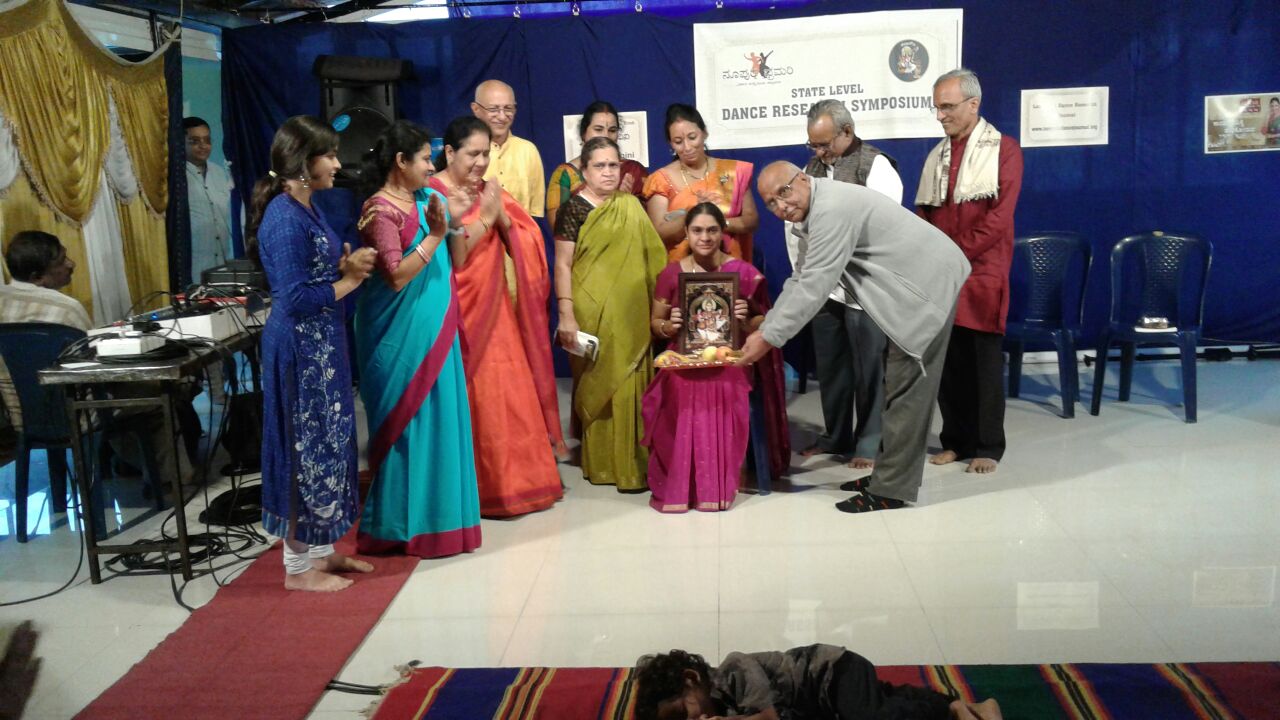
Felicitation to Shalini
ಇದಾದ ಬಳಿಕ ‘ಕಲಾಗೌರಿ ಸಂಧ್ಯೆ’ ನೃತ್ಯ ಕಾರ್ಯಕ್ರಮದಲ್ಲಿ ನೂತನ ಶಿಲ್ಪ ಪ್ರಸಕ್ತಿಯನ್ನು ಆಧರಿಸಿದ ಕಲಾಗೌರಿ ಸ್ತುತಿಯನ್ನು ಮಧುಲಿಕಾ ಶ್ರೀವತ್ಸ ಅವರು ಪ್ರಸ್ತುತಪಡಿಸಿದರು. ಶಾಲಿನಿ ವಿಠಲ್ ಅವರ ಆರಾಧ್ಯ ಮೂರ್ತಿ ಕಲಾಗೌರಿಯು ಡಾ. ಮನೋರಮಾ ಬಿಎ. ಎನ್ ಅವರ ಸಂಶೋಧನ ಪ್ರಸ್ತುತಿಗಳಲ್ಲೂ ಒಂದಾಗಿದೆ. ಕೊರ್ಗಿ ಶಂಕರನಾರಾಯಣ ಉಪಾಧ್ಯಾಯರು ಕಲಾಗೌರಿ ಕೃತಿಯನ್ನು ರಚಿಸಿದ್ದರೆ, ನೃತ್ಯವಿನ್ಯಾಸ-ನಿರ್ದೇಶನವನ್ನು ಡಾ.ಶೋಭಾ ಶಶಿಕುಮಾರ್ ಮಾಡಿರುತ್ತಾರೆ.
ಲೀಲಾಶುಕನ ಕೃಷ್ಣ ಕರ್ಣಾಮೃತವನ್ನಾಧರಿಸಿ ಬರೆದ ಕನ್ನಡ ಅವತರಣಿಕೆಯ ಮೊದಲ ಕನ್ನಡ ಪದವರ್ಣದ ಪ್ರಸ್ತುತಿ-‘ವಂಶೀವಿಲಾಸ ’- ಮಧುಲಿಕಾ ಶ್ರೀವತ್ಸ ಅವರ ಮತ್ತೊಂದು ನೃತ್ಯಪ್ರಸ್ತುತಿಯಾಗಿತ್ತು.
ಕೊರ್ಗಿ ಶಂಕರನಾರಾಯಣ ಉಪಾಧ್ಯಾಯ ಮತ್ತು ಡಾ.ಮನೋರಮಾ ಬಿ.ಎನ್ ಅವರ ಸಾಹಿತ್ಯರಚನೆ ಮತ್ತು ಕಾಂಚನಾ ರೋಹಿಣಿ ಸುಬ್ಬರತ್ನಂ ಅವರ ನಿರ್ದೇಶನದಲ್ಲಿ ವಿದುಷಿ ಶ್ರುತಿರಂಜನಿ ಕಾಂಚನಾ ಅವರ ಸಂಗೀತ-ಸ್ವರ ಸಂಯೋಜನೆ ಈ ಪದವರ್ಣಕ್ಕಿದೆ. ಮಧುಲಿಕಾ ಅವರ ಸಂಶೋಧನೆ – ನಾಯಿಕೆಯರ ನೃತ್ಯಸಾಹಿತ್ಯಗಳಲ್ಲಿ ನಾಯಕಭಾವದ ಪಾತ್ರದ ಕುರಿತ ಅಂಗವಾಗಿ ಈ ಪದವರ್ಣದ ನೃತ್ಯವನ್ನು ಆಯೋಜಿಸಲಾಗಿತ್ತು.
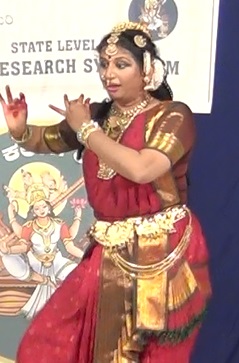
Dr.Shobha as Krishna
ನಂತರದಲ್ಲಿ ಡಾ. ಶೋಭಾ ಶಶಿಕುಮಾರ್, ನೃತ್ಯವಿದ್ವಾಂಸರು, ಸಂಶೋಧಕರು, ಇವರಿಂದ ಭರತನೃತ್ಯ ಕಾರ್ಯಕ್ರಮ ಮೂಡಿಬಂದಿತು. ಕೊರ್ಗಿ ಶಂಕರನಾರಾಯಣ ಉಪಾಧ್ಯಾಯರ ರಚನೆಯಲ್ಲಿ ಕೃಷ್ಣನ ಆಟೋಟ-ಬಾಲಲೀಲೆಗಳ ಕುರಿತ ರಚನೆಯಲ್ಲಿ ರಂಗವನ್ನೇರಿದ ಶೋಭಾ ಅವರು, ನಂತರದಲ್ಲಿ ಶತಾವಧಾನಿ ಡಾ. ಆರ್.ಗಣೇಶರು ರಚಿಸಿದ ಪ್ರೋಷಿತಪತಿಕಾ ನಾಯಿಕೆಯ ಪದವನ್ನು ಅಭಿನಯಿಸಿದರು. ಅನ್ನಮಾಚಾರ್ಯರ ಪ್ರಸಿದ್ಧ ಕೃತಿ ಬ್ರಹ್ಮಮೊಕ್ಕಟೇಯಲ್ಲಿ ಮನೋಜ್ಞವಾಗಿ ವ್ಯಾಖ್ಯಾಭಿನಯವನ್ನು ನೀಡಿ ಸಹೃದಯರ ಕಣ್ಣುಗಳನ್ನು ಹನಿಗೂಡಿಸಿ ಧನ್ಯಭಾವವನ್ನು ಹೊಮ್ಮಿಸಿದರು. ಇದೇ ಸಂದರ್ಭದಲ್ಲಿ ಡಾ. ಶೋಭಾ ಶಶಿಕುಮಾರ್ ಅವರಿಗೆ ನಾಟ್ಯಭಾರತಿ ಎಂಬ ಬಿರುದನ್ನಿತ್ತು ಸನ್ಮಾನಿಸಲಾಯಿತು.
ಹಿಮ್ಮೇಳದಲ್ಲಿ ನಾಗಶ್ರೀ ನಾರಾಯಣ್ (ಗಾಯನ), ಮೇಘಾ ಶ್ರೀನಿವಾಸ್ (ನಟುವಾಂಗ), ವಿದ್ವಾನ್ ಗಿರಿಧರ್ (ಮೃದಂಗ) ಮತ್ತು ಪ್ರಮುಖ್ (ಕೊಳಲು) ಅವರು ಹಿಮ್ಮೇಳದಲ್ಲಿ ಶೋಭಾಯಮಾನವಾದ ಅಭಿವ್ಯಕ್ತಿಯನ್ನು ನೀಡಿದರು. ನೃತ್ಯನಿರೂಪಣೆಯನ್ನುಕೊರ್ಗಿ ಶಂಕರನಾರಾಯಣ ಉಪಾಧ್ಯಾಯರು ನೆರವೇರಿಸಿದರೆ, ಧನ್ಯವಾದ ಸಮರ್ಪಣೆಯನ್ನು ಡಾ. ಮನೋರಮಾ ಬಿ.ಎನ್ ಅವರು ಮಾಡಿದರು.
ಇದೇ ಸಂದರ್ಭ ನೃತ್ಯಾಧ್ಯಯನಸಂಬಂಧೀ ಪುಸ್ತಕ ಮತ್ತು ನಿಯತಕಾಲಿಕೆಗಳ ಪ್ರದರ್ಶನ ಮತ್ತು ಮಾರಾಟವನ್ನೂ ಏರ್ಪಡಿಸಲಾಗಿತ್ತು.